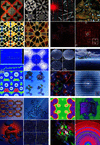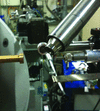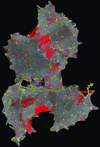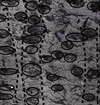issue contents
January 2015 issue

editorial
GENERAL
IUCrJ is a fully open-access journal that publishes high-quality structural science papers. It has had a successful first year of publication.
scientific commentaries
PHYSICS | FELS
Serial crystallography should be possible with a much wider range of radiation sources as Ayyer et al. [IUCrJ (2015), 2, 29–34] show that crystallographic intensities can be recovered from randomly oriented frames which are too sparse for indexing.
CHEMISTRY | CRYSTENG
Using the combined techniques of photocrystallography and infrared spectroscopy is a very powerful method for generating and establishing the structures of metastable linkage isomers in the solid state as exemplified by the work of Casaretto et al. [IUCrJ (2015), 2, 35–44] on [RuCl(NO)2(PPh3)2]BF4.
PHYSICS | FELS
Precession electron diffraction has solved a long-standing challenge in electron diffraction. Further progress promises a general technique for structure determination of difficult crystals.
research papers
BIOLOGY | MEDICINE
An extended analysis of structural ensembles obtained from small-angle X-ray scattering data reveals subclass-specific conformational preferences of IgG antibodies, which are largely determined by the hinge-region structure.
CHEMISTRY | CRYSTENG
Download citation


Download citation


A novel sample cell with control of temperature and relative humidity permitted collection of data of excellent quality, enabling unrestrained refinement of all atomic parameters. One of the K atoms in the structure is disordered; very strong anisotropy in three of the four water O atoms indicates partial static disorder which does not involve the bonded H atoms.
CCDC reference: 1030936
PHYSICS | FELS
A demonstration is given of three-dimensional crystal intensity reconstruction from sparse data, of a nature likely to be encountered in serial microcrystallography experiments at synchrotron sources.
CHEMISTRY | CRYSTENG
Download citation


Download citation


Photocrystallographic and IR analysis reveal light-induced reversible metastable NO linkage isomers in the dinitrosyl compound [RuCl(NO)2(PPh3)2]BF4.
CCDC reference: 1036237
feature articles
BIOLOGY | MEDICINE
This paper presents a variety of techniques and technologies aimed at the transformation of crystallographic data into information and knowledge.
CHEMISTRY | CRYSTENG
This article reports unique pattern formation processes and mechanisms via crystallization of materials under external fields as one of the general problems in statistical physics of open nonequilibrium phenomena. Specifically, the article clarifies for the first time the role of external fields on the crystallization of homogeneous solutions of flexible polymers having enormously large conformational entropy into unique shish-kebab and extended-chain crystal textures.
PHYSICS | FELS
A modulation wave approach is used to interpret the coupled longer range and truly short-range order hidden in the highly structured diffuse intensity distributions of three representative such systems. Both the longer range order and the truly short-range order simultaneously encoded in such highly structured diffuse intensity distributions are highlighted.
PHYSICS | FELS
The crystal structures of various mixed Li and transition metal fluoride phosphates are reviewed, with a special focus on their applicability as cathode materials for Li-ion batteries.
BIOLOGY | MEDICINE
ARCIMBOLDO replaces the atomicity constraints required for ab initio phasing by enforcement of model stereochemistry. Small model fragments and local folds are exploited at resolutions up to 2 Å in different contexts, from supercomputers to the standalone ARCIMBOLDO_LITE, which solves straightforward cases on a single multicore machine.
NEUTRON | SYNCHROTRON
Advanced grazing-incidence techniques have developed significantly during recent years. With the ongoing progress in instrumentation, novel methods have emerged which allow for an in-depth morphology characterization of modern soft-matter materials. Examples are in situ and in operando grazing-incidence small-angle X-ray scattering (GISAXS), micro- and nanofocused GISAXS, time-of-flight (TOF) grazing-incidence small-angle neutron scattering (GISANS) and surface-sensitive resonant soft X-ray scattering techniques, including the potential to investigate polarization. Progress in software for data analysis is another important aspect.
topical reviews
PHYSICS | FELS
This topical review highlights progress made recently in the development and application of precession electron diffraction (PED) and its scanning variant for the determination of unknown crystal structures and the mapping of orientations at the nanoscale.
PHYSICS | FELS
An overview is given to recent advances in the field of modulated molecular and inorganic crystals. The importance of detailed knowledge of the modulated structure to understand crystal chemistry and the functional properties of the modulated phases is outlined.



 journal menu
journal menu




 access
access



























